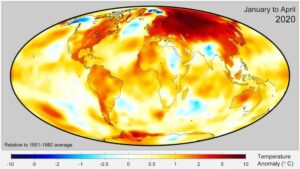In News
- Zombie fires’ becoming more frequent in the Arctic in addition to fires occurring in the once-frozen tundra.
What are Zombie fires?
- Zombie fires occur when a fire from a previous year smolders in carbon-rich peat (organic fuel) underground during the winter, then re-ignite on the surface as the weather warms and the ground thaws the next season.
- This can lead to even more burning the following year.
- The process is made worse as peat and permafrost, both carbon sinks which act to hold and store carbon, now become a carbon source.
- Emissions increase as both the burning of vegetation and burning of peat/permafrost release CO2 into the atmosphere, furthering our planet’s warming.
- The fires in the Arctic spreading to areas which were formerly fire-resistant is a more worrying feature.
- The tundra is drying up and vegetation there like moss, grass, dwarf shrubs, etc are starting to catch fire.
- The tundra is a cold region of treeless level or rolling ground found mostly north of the Arctic Circle or above the timberline on mountains.
- In 2019 and 2020, burning occurred well above the Arctic Circle, a region not normally known to support large wildfires. Wildfires on permafrost in Siberia south of the Arctic are not uncommon.

Why is a ‘zombie fire’ dangerous?
- Zombie fires are part of a dangerous “feedback loop”.
- The growing number of extreme wildfires in the Arctic are unprecedented in the past 10,000 years.
- These fires can burn underground for years, thawing permafrost and releasing huge amounts of carbon into the atmosphere, creating feedback loops resulting in accelerated warming and more thawing permafrost.
- The combination of wildfires and permafrost thaw can cause loss of life, landslides, floods, and coastal erosion threatening Arctic communities, infrastructure and wildlife.
Need of the hour:
- There is an urgent need to understand the nature of fires in the Arctic which are evolving and changing rapidly.
- The issue needs to be taken up as an issue of global importance.
- There is a need for global cooperation, investment and action in monitoring fires.
- Also needed was the learning from indigenous people of the Arctic about how fire was traditionally used.
- New permafrost- and peat-sensitive approaches to wildland firefighting are also needed to save the Arctic.

Source: Down to Earth
















